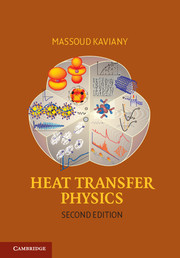Book contents
- Frontmatter
- Dedication
- Contents
- Preface
- Acknowledgments
- 1 Introduction and Preliminaries
- 2 Molecular Orbitals/Potentials/Dynamics and Quantum Energy States
- 3 Carrier Energy Transport and Transformation Theories
- 4 Phonon Energy Storage, Transport, and Transformation Kinetics
- 5 Electron Energy Storage, Transport, and Transformation Kinetics
- 6 Fluid Particle Energy Storage, Transport, and Transformation Kinetics
- 7 Photon Energy Storage, Transport, and Transformation Kinetics
- APPENDIX A Tables of Properties and Universal Constants
- APPENDIX B Derivation of Green–Kubo Relation
- APPENDIX C Derivation of Minimum Phonon Conductivity Relations
- APPENDIX D Derivation of Phonon Boundary Resistance
- APPENDIX E Derivation of Fermi Golden Rule
- APPENDIX F Derivation of Equilibrium, Particle Probability Distribution Functions
- APPENDIX G Phonon Contributions to the Seebeck Coefficient
- APPENDIX H Monte Carlo Method for Carrier Transport
- APPENDIX I Ladder Operators
- Nomenclature
- Abbreviations
- Glossary
- References
- Index
1 - Introduction and Preliminaries
Published online by Cambridge University Press: 05 June 2014
- Frontmatter
- Dedication
- Contents
- Preface
- Acknowledgments
- 1 Introduction and Preliminaries
- 2 Molecular Orbitals/Potentials/Dynamics and Quantum Energy States
- 3 Carrier Energy Transport and Transformation Theories
- 4 Phonon Energy Storage, Transport, and Transformation Kinetics
- 5 Electron Energy Storage, Transport, and Transformation Kinetics
- 6 Fluid Particle Energy Storage, Transport, and Transformation Kinetics
- 7 Photon Energy Storage, Transport, and Transformation Kinetics
- APPENDIX A Tables of Properties and Universal Constants
- APPENDIX B Derivation of Green–Kubo Relation
- APPENDIX C Derivation of Minimum Phonon Conductivity Relations
- APPENDIX D Derivation of Phonon Boundary Resistance
- APPENDIX E Derivation of Fermi Golden Rule
- APPENDIX F Derivation of Equilibrium, Particle Probability Distribution Functions
- APPENDIX G Phonon Contributions to the Seebeck Coefficient
- APPENDIX H Monte Carlo Method for Carrier Transport
- APPENDIX I Ladder Operators
- Nomenclature
- Abbreviations
- Glossary
- References
- Index
Summary
The macroscopic heat transfer rates use thermal-energy related properties, such as the thermal conductivity, and in turn these properties are related to the atomic-level properties and processes. Heat transfer physics addresses these atomic-level processes (e.g., kinetics). We begin with the macroscopic energy equation used in heat transfer analysis to describe the rates of thermal energy storage, transport (by means of conduction k, convection u, and radiation r), and conversion to and from other forms of energy. The volumetric macroscopic energy conservation (rate) equation is listed in Table 1.1. The sensible heat storage is the product of density and specific heat capacity ρcp, and the time rate of change of local temperature ∂T/∂t. The heat flux vector q is the sum of the conductive, convective, and radiative heat flux vectors. The conductive heat flux vector qk is the negative of the product of the thermal conductivity k, and the gradient of temperature ∇T, i.e., the Fourier law of conduction. The convective heat flux vector qu (assuming net local motion) is the product of ∇cp, the local velocity vector u, and temperature. For laminar flow, in contrast to turbulent flow that contains chaotic velocity fluctuations, molecular conduction of the fluid is unaltered, whereas in turbulent flow this is augmented (phenomenologically) by turbulent mixing transport (turbulent eddy conductivity). The radiative heat flux vector qr = qph (ph stands for photon) is the spatial (angular) and spectral integrals of the product of the unit vector s and the electromagnetic (EM), spectral (frequency dependent), directional radiation intensity Iph,ω, where ω is the angular frequency of EM radiation (made up of photons).
- Type
- Chapter
- Information
- Heat Transfer Physics , pp. 1 - 49Publisher: Cambridge University PressPrint publication year: 2014
- 1
- Cited by



